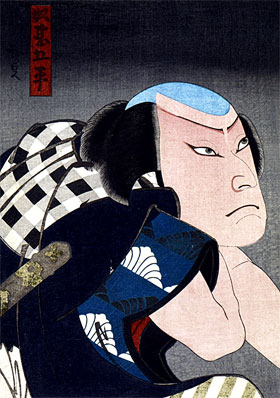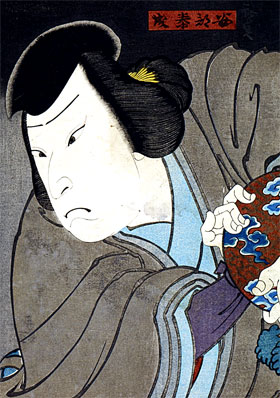| TAMAMO-NO-MAE ASAHI NO TAMOTO |
| Play title | Tamamo-no-Mae Asahi no Tamoto Tamamo-no-Mae Obana no Nishiki |
| Authors | Namioka Kippei / Asada Icch˘ / Yasuda Akei (1751 original version) Chikamatsu Baishiken / Sagawa T˘ta (1806 revision) |
| History |
The play "Tamamo-no-Mae Asahi no Tamoto" was originally written for the puppet theater (Bunraku) and staged for the first time in the 1st lunar month of 1751 in ďsaka at the Toyotakeza. It was adapted for Kabuki in the following days and staged for the first time in Ky˘to in the 1st lunar month of 1751 at Miyako Handayű 's theater [more details]. The play was revived and revised for the puppet theater in 1806 by Chikamatsu Baishiken and Sagawa T˘ta. This revision was staged in a minor puppet theater in the 3rd lunar month of 1806 in ďsaka. This revision was adapted for Kabuki several years later, in the 7th lunar month of 1811 at the Ichimuraza [more details]. "Tamamo-no-Mae Asahi no Tamoto" was revived as a t˘shi ky˘gen at the National Theatre in December 1980. |
| Structure |
"Tamamo-no-Mae Asahi no Tamoto" was a 5-act drama. The most important scene, which is still part of the current Kabuki repertoire, is "Michiharu Yakata", the final scene (kiri) of the third act. The nickname of this scene is "Tamasan", with tama being the first ideogram of Tamamo-no-Mae and san meaning third (act). |
| Key words |
Abe Yasunari Gidayű Ky˘gen Jidaimono J˘shi Kenshunmon Kitsune Kitsunebi Kiyomizudera K˘shitsu Kyűbi no Kitsune Migawari Morokoshi Naginata Nasuno-ga-Hara Onmy˘d˘ Onmy˘ji Onna Bud˘ ďuchi Seiry˘den Sessh˘seki Tamamo-no-Mae Tenjiku Toba Tenn˘ Yakata Yakko |
| Summary |
Kiyomizu The scene opens at the Kiyomizu Temple in Ky˘to. The country is at peace under the rule of Emperor Toba. However, his elder brother, Prince Usugumo, is resentful because he has not been made Emperor. He was born the day of an eclipse of the sun. This coincidence was interpreted as a bad omen and he could not become emperor. Prince Usugumo is plotting secretly to seize power. He orders his retainer Washizuka Kint˘ji to steal a sacred sword in the house of Fujiwara Michiharu [2], the late Prime Minister of the Right (udaijin). Once the sword is in his possession, he will use it to unite all the warriors of Japan against Emperor Toba. The sword came from Tenjiku and was the same one used to defeat the golden fox with nine tails, and is now one of the most precious court treasures. Prince Usugumo is also enamoured of Michiharu's daughter, Princess Katsura, but she has not yet responded to his advances. He orders Kint˘ji to kill her if she does not agree to become his lover. Prince Usugumo's procession departs, and Princess Katsura, herself, appears. She has come to pray at the temple. Meeting Abe Unemenosuke Yasuaki [3], whom she loves, they declare their mutual love. Inubuchi Genz˘, one of Usugumo's retainers, attempts to abduct Princess Katsura but Unemenosuke easily repulses him. Michiharu Yakata The scene opens at the mansion of late Fujiwara Michiharu, where his widow Hagi-no-Kata [4] and their two daughters, Princess Katsura and Princess Hatsuhana, live. Princess Katsura is already famous for her beauty. Prince Usugumo has frequently asked for her hand, but she has always rejected him since she is already in love with Abe Unemenosuke. They are concerned about the loss of the family heirloom, a sacred sword from Tenjiku which has been a possession of their family for generations. The k˘shitsu Hagi-no-Kata, urges Unemenosuke to find it. Washizuka Kint˘ji arrives at the mansion. He is a messenger (j˘shi) sent by Prince Usugumo, who demands either the head of Princess Katsura or the sacred sword. The ultimatum is very short: the sword or the severed head has to be brought back to the palace of Prince Usugumo before the end of the day. Hagi-no-Kata can't see any way to meet this cruel demand. Unaware that the two girls are listening, she explains that Princess Katsura is not her real daughter, but that she found her, abandoned, at the Kiyomizu Temple. Frightened that Princess Katsura may be protected by the gods, Hagi-no-Kata strongly urges that her real daughter, Princess Hatsuhana, be substituted (migawari). Kint˘ji refuses, but he is moved by Hagi-no-Kata's supplication. He decides to make the two girls play dice and to kill the loser. The two girls play for their lives and Princess Hatsuhana loses. She rejoices that she can take her sister's place. Kint˘ji is about to cut off her head, but he suddenly strikes and kills Princess Katsura. Hagi-no-Kata is aghast and she strikes and wounds Kint˘ji with her naginata. Unemenosuke, who has been watching from a neighbouring room, rushes out to help. Kint˘ji explains that he is the real father of Princess Katsura, and that he has decided to kill her to spare the live of Hagi-no-Kata's real daughter. He tells them that he stole the sacred sword. The sword is hidden in the palace of Prince Usugumo. While the old warrior weeps, Unemenosuke takes the head and goes to Prince Usugumo's palace to exchange it for the sword. An imperial messenger arrives from the court to announce that a poem composed by Princess Hatsuhana was appreciated and approved by the Imperial Court. As a consequence of this selection, she will become one of the Emperor's concubines, taking the court name of Tamamo-no-Mae. She prepares to go to the palace, but grieves for her sister who was sacrificed. ďuchi Kenshunmon Mae The scene opens at the Kenshun Gate of the Imperial Palace in Ky˘to. Servants are cleaning and gossiping about the arrival of a new beautiful concubine. She is expected to make her entry into the palace today. Princess Hatsuhana appears, accompanied by Abe Unemenosuke. From today her name will change to Tamamo-no-Mae and she will live a life of luxury and leisure as one of the imperial concubines. But she still weeps for the cruel death of her sister Princess Katsura. Suddenly, a strange wind blows, and the girl is enveloped in a black cloud with fox fires flash-lightning and illuminating the air (kitsunebi). Unemenosuke draws his sword and drives them away, but it is too late, the girl has been possessed by the spirit of the fox. ďuchi Okuden R˘ka The female fox demon that has possessed Tamamo-no-Mae, remembering its failures in Tenjiku and Morokoshi, is determined to take over the Empire of the Rising Sun. And the fox is not alone, since Prince Usugumo is also scheming to become Emperor. Prince Usugumo appears in the corridor at the back of the palace, and flirts with Tamamo-no-Mae. He tells her of his plans and she feels moved to reveal her true identity. They agree to join forces in order to get rid of Emperor Toba. Meanwhile, the Empress Bifukumon'in [5] together with the other imperial concubines, are jealous of Tamamo-no-Mae for monopolizing the Emperor's attentions. They plan to kill her. The lamps in the corridor have been blown out by the wind. Tamamo-no-Mae comes along and the women attempt to set upon her in the darkness. As they try to stab her, however, light streams from the girl's body and then she disappears. The women are confused. Unemenosuke hurries up and decides to report to Emperor Toba what has happened. He is stopped by Prince Usugumo who declares that the Emperor is sick and that he, Usugumo, will temporarily take control of the empire. Unemenosuke asks his brother, the onmy˘ji Abe no Yasunari, to divine Tamamo-no-Mae's true nature. Seiry˘den The scene opens at the Seiry˘den. Emperor Toba has always enjoyed good health, but recently he has been unwell. Taking advantage of this, Prince Usugumo has seized control. The onmy˘ji Abe Satsuma-no-Kami Yasunari has come at Emperor Toba's private residence to investigate the strange behaviour of Tamamo-no-Mae. He demands a confrontation with her, and she appears, accompanied by court ladies. Yasunari mentions the recent incident in the corridor and accuses Tamamo-no-Mae of being a witch. The girl replies, however, that, since she is without sin, it is not unnatural for light to radiate from her body, and skilfully parries his questions. Yasunari thinks again, and declares that he will exorcise the Emperor's illness using the girl as a medium. He hopes that this will reveal Tamamo-no-Mae for what she really is, but the exorcism has no effect, and the girl laughs derisively. Unemenosuke arrives on the scene with the sacred sword of Fujiwara Michiharu, which he has successfully retrieved. Confronted with the weapon, Tamamo-no-Mae immediately changes into a fox and rises into the air and disappears. Left without his ally, Prince Usugumo prepares to fight to the last as the warrior Miuranosuke Yoshiaki and his men arrive with orders from the Emperor to apprehend his evil brother. There is the sound of thunder and explosions and the building collapses. The fox appears once more on the roof, and then flies off towards far from the Imperial City of Ky˘to to the Nasuno Heath. Nasuno-ga-Hara Sessh˘seki Pursued by the warriors Miuranosuke Yoshiaki and Kazusanosuke Hirotsune, the nine-tailed fox has fled to the Nasuno Heath, where it has taken refuge among volcanic lava emitting poisonous fumes. There, the fox goes through a bewildering series of changes. It starts with a blind masseur. Then it becomes a young girl. It ends with a yakko. Armed with the sacred sword and a magic mirror, however, the two warriors face the lava and the fox is finally made to emerge. The play ends before the killing of the female fox demon by an arrow and the transformation of its dead body into a stone named Sessh˘seki, the Deadly Stone of the legend. |
| Notes |
[1] Act I and act II are respectively set in India and China. From act III, all the scenes are set in Japan. [2] Another possible reading is Fujiwara no D˘shun. [3] Abe Unemenosuke belong to the prestigious Abe clan, whose males are all experts in onmy˘d˘. [4] The role of Hagi-no-Kata is a good example of onna bud˘. [5] Bifukumon'in was the title of Fujiwara no Nariko (1117 ~ 1160), the daughter of Fujiwara no Nagazane, spouse of Empreror Toba and mother of Emperor Konoe. |
 |
 |
|
|
The actors Arashi Rikaku II and Kataoka Gad˘ II playing the roles of the yakko Jingohei and Abe no Yasunari in the drama "Tamamo-no-Mae Asahi no Tamoto", which was staged in the 1st lunar month of 1850 at the Chikugo no Shibai (print made by Utagawa Hirosada) |
||
|
|
| Contact | Main | Top | Updates | Actors | Plays | Playwrights | Programs | Links | FAQ | Glossary | Chronology | Illustrations | Prints | Characters | Derivatives | Theaters | Coming soon | News |